

|
Back to |
| The Front Page |
| News & Features |

|
When will Sonoma-Cutrer re-start its croquet programs? |
|
By Mike Orgill Photos by Mike Orgill and others as credited Posted July 14, 2020
|
Members of the San Francisco Croquet Club first encountered Brice Jones on the SFCC lawn when he came down to San Francisco; Jones was contemplating making croquet part of the corporate image for his magnificent new winery. We all called Sonoma-Cutrer "Croquet Heaven," for its beauty and the very special grace of its setting in the hills of Sonoma County, whose climate is perfect for wine produced from the Chardonnay and Pinot Noir grapes. We believe that Brown-Forman will surely re-open--for its customers, the club,, and world-class players--within the proper limits of corporate responsibility. The big question, for us all, is WHEN?
What is the current situation of croquet at Sonoma-Cutrer Winery, one of the heritage sites of world croquet? What makes Sonoma-Cutrer unique in croquet history?
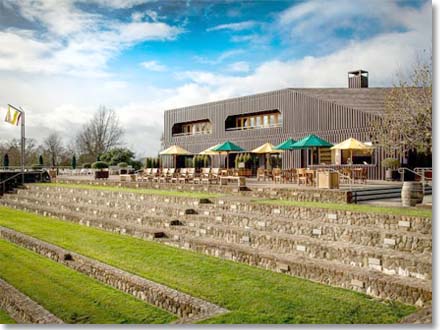
|
| The croquet courts are ringed with exquisite stonework, designed for tables and for sitting, and blending in with perhaps the most beautiful croquet venue in America. |
Brice Jones, an Air Force fighter jet pilot and Harvard Business School graduate, assembled a group of investors in the mid-1970s and purchased Sonoma County vineyards in the Russian River Valley. They were riding the upward curve of chardonnay popularity and the increasing prestige of the Sonoma wine country.
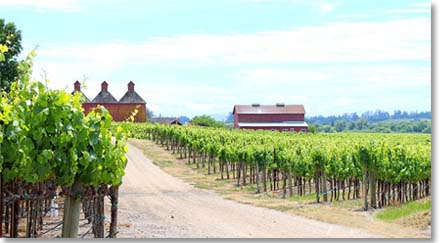
|
| The facility is surrounded by vineyards that supply many vintage grapes for Sonoma- Cutrer's Chardonnay wine. |
First came the establishment of the vines
In the beginning the group sold their premium quality chardonnay grapes to high-end winemakers. As the demand for their grapes grew, Jones and his group decided to build a showcase winery and make their own wine, specializing in chardonnay.
Showplace wineries need signature features such as ornate gardens or striking architecture in stunning settings. Sonoma-Cutrer had a spectacular setting, so two state-of-the-art croquet courts became the "special feature," two perfectly designed croquet courts as a site for a world invitational tournament as a major charitable event for the local society set.

|
| A player's viewpoint of croquet, from the southern edge of the two courts. |
Jones hired Neil Spooner, a top Australian player, to select entrants from among the top competitors in each croquet-playing country. His invitation was irresistible: it covered not only most of their air fare, expenses and housing, but also the lavish hospitality he would provide, all in exchange for playing a game they loved--not to speak of the chance to win a world championship, which had never been done, by anyone, anywhere.
"I realized what a task we'd set ourselves to build first-class croquet courts," Jones recalled in 1995. "But we'd built the best wine facility we could and we were making the best wine we could, and I wasn't going to shortchange it when it came to the courts."
Then came the players - only the best, from everywhere
Sonoma-Cutrer mounted the first invitational tournament in 1986, in the singles format it would follow for all of its history. Almost every top player competed during its 1986 to 2003 tournament run. Mulliner, Jones, Cleland, Maugham, Fulford, Taylor, Westerby, Clarke, Fournier (the first American winner, in 1999), and Bamford (the winner of the last tournament) all won the championship, with Stephen Mulliner claiming four titles.
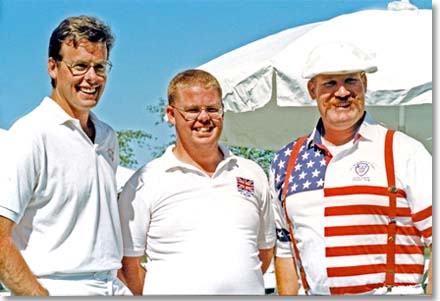
|
| A youthful Reg Bamford (South Africa) David Maugham (England) and Jerry Stark (United States) represented their countries at the event in 1994. Mike Orgill photo. |
Jones dubbed it "The World Croquet Championship" and it was unique in world croquet. The World Croquet Federation's own "world championship" was not to debut until 1989 in London. (Won by Joe Hogan, also a veteran at Sonoma-Cutrer.)
At its height over 1,000 spectators ringed the courts on finals day, most sporting white croquet garb. Over the life of the tournament millions of dollars were raised for charity via a high-level wine auction.
Creating a must-see event for charity in Sonoma County
The WCC was an "artistic" success from the first. Attendance and sponsorship started small but grew rapidly beyond all expectations.
Area residents would scramble to get tickets to the highest-profile charity event in the county - even though they did not understand the game they were "watching" from their tables!
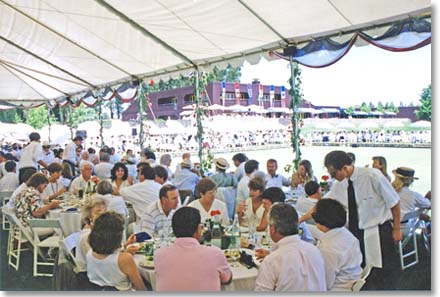
|
| By 2001, the event was an enormous success--for the socialites of Sonoma County, for the charity, for the players, for the sport, and for the winery. Sonoma-Cutrer photo. |
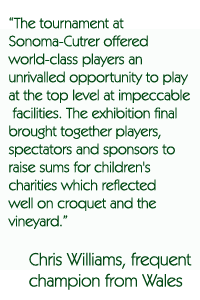 The Sonoma-Cutrer tournament catalyzed Association Laws Croquet in the United States. The Arizona Croquet Club had been the major US pioneers of the game most played in every other country. But then, it was Sonoma-Cutrer and pressure from the top US players which sparked the further growth of Association Croquet in the US.
The Sonoma-Cutrer tournament catalyzed Association Laws Croquet in the United States. The Arizona Croquet Club had been the major US pioneers of the game most played in every other country. But then, it was Sonoma-Cutrer and pressure from the top US players which sparked the further growth of Association Croquet in the US.
Croquet at Sonoma-Cutrer and both Neil Spooner's and Damon Bidencope's mentorship caused an explosion of high-level croquet in the SF Bay Area, which then fanned out across the country and threatened the USCA old guard in the person of USCA founder Jack Osborn, who dubbed the West Coast renegades the "Western Killers".
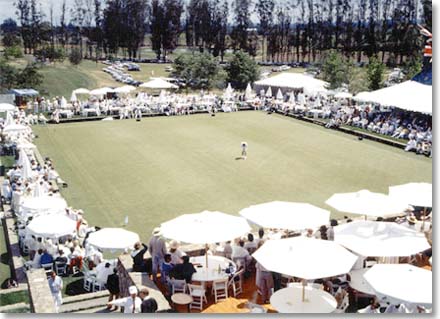
|
| The crowd watching the 1991 event knew it was a consequential shot, as Jim Bast of Arizona approached the rover peel. Sonoma-Cutrer photo |
The San Francisco Bay Area became a powerhouse of top-level play both in AC and American rules play from the late-eighties to the mid-nineties. The San Francisco Open was the most competitive American rules tournament in the country for many years in the 90's, with international stars such as Fulford, Clarke, Prince, and many more going directly from competing at Sonoma-Cutrer to playing the unfamiliar (but strangely fascinating) American game in San Francisco.
It was a new hub for both pros and top-level players
Spooner at Sonoma-Cutrer, Damon Bidencope and Jerry Stark at Meadowood became croquet pros, and the core of players at the San Francisco Croquet Club--John Taves, Wayne Rodoni, Phil Arnold, Erv Peterson, Charlie Smith, Carl Hanson, Reuben Edwards and others all created this blossoming of croquet in the most unexpected place - the far west, which still has relatively few associated USCA players compared to the east.
Jerry Stark was the croquet pro at Meadowood and hosted a top-level Association Croquet tournament every summer there until his death in 2010. His passing seemed to mark the beginning of the slow demise of top-level croquet in the Bay Area, coming on the heels of the retirement of the International Players in San Francisco - Rodoni, Taves, Hanson - or their moving out of the area.
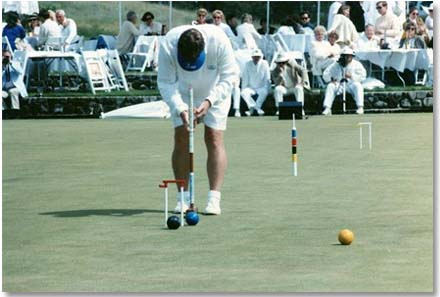
|
| Mike Orgill took this photograph thinking that the American Jim Bast was about to win the event-- but he over-rolled his rover peel, allowing David Maugham the victory in 1991. |
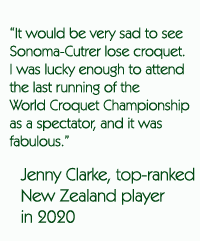 After Sonoma-Cutrer was sold to the Brown-Forman Corporation in 1999, the San Francisco club continued a slow decline, and croquet activities at Meadowood was restricted to Golf Croquet for guests only. The Sonoma-Cutrer World Croquet Championship held one last go-around in 2003 and croquet in the Bay Area was eventually left with the Sonoma Croquet Club at Sonoma-Cutrer and a one-court club in Oakland.
After Sonoma-Cutrer was sold to the Brown-Forman Corporation in 1999, the San Francisco club continued a slow decline, and croquet activities at Meadowood was restricted to Golf Croquet for guests only. The Sonoma-Cutrer World Croquet Championship held one last go-around in 2003 and croquet in the Bay Area was eventually left with the Sonoma Croquet Club at Sonoma-Cutrer and a one-court club in Oakland.
The Sonoma Croquet Club continued to host tournaments and club events, including the North American Open (a championship AC event) and the North American Amateur (an AC event for sub-1700 dynamic grade players). The winery ran an active croquet program, "Chardonnay and Croquet" and other croquet and wine connoisseurship events. That was where things stood until the Pandemic hit and Sonoma County and the rest of the Bay Area shut down in mid-March.
"How soon" is now everyone's question.
What is the outlook for croquet at Sonoma-Cutrer today? According to sources at the winery Brown-Forman, like almost any organization involving groups of people in any configuration, is planning to reopen in stages. Croquet may resume in a corporate "third stage" which would come after the tasting room and tours re-open. Everything depends on the direction of the pandemic.
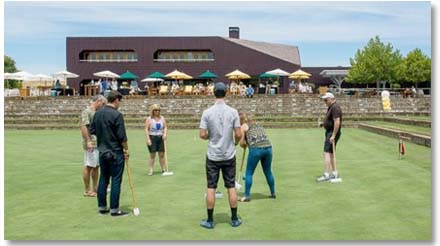
|
| Croquet is a uniquely "special feature" at the winery, where club members are glad to help with tour groups. |
As of this writing, in mid-July 2020, the winery tasting room is still closed and the winery is in a production-only and on-line sales mode. Brown-Forman is following the Sonoma County health authority's guidelines, but a reopening still seems uncertain for winery visitors and Sonoma Croquet Club members, as all bars and restaurants have also been ordered closed as of Monday, July 13 by Sonoma authorities as local case levels rise.
When the Pandemic is again in retreat and Sonoma-Cutrer dares to re-open with a croquet club, what player guidelines should we expect?
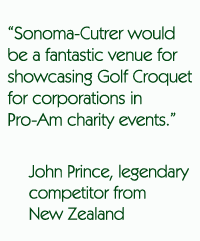 Association or American-rules croquet both seem safer, since social distancing is easy to maintain if you are the in-player running a break or are watching your opponent run a break against you. Golf Croquet may find it harder to social distance since "social" GC players tend to flock around the court in tight groups, especially when they play doubles.
Association or American-rules croquet both seem safer, since social distancing is easy to maintain if you are the in-player running a break or are watching your opponent run a break against you. Golf Croquet may find it harder to social distance since "social" GC players tend to flock around the court in tight groups, especially when they play doubles.
Croquet at Sonoma-Cutrer is now mostly Golf Croquet, especially in winery groups attracted on tours precisely because of the croquet on offer. That means close monitoring of all groups.
Masks will be a must, of course. But how do you drink wine? Disinfection of mallets balls, hoops, clips, chairs, and surfaces will be de rigueur. The number of players per court will be limited. Social Distancing will be the rule for all visitors to the winery. And sadly, tournaments are on hold until the virus is defeated.
But this is only for the NEAR future - until an effective vaccine for the Covid-19 virus is discovered and deployed. This could happen within a few months, or before the end of the year, the experts are saying.
Sonoma Croquet Club members look forward to being back on the courts in a few months. As always, they will support Brown-Forman in resuming the one thing that makes Sonoma-Cutrer "special" besides its prize-winning Chardonney and Pinot Noir: the croquet that is an historic part of its heritage.
Mike Orgill is the long-time president of Sonoma Croquet Club and a member of the Croquet Foundation of America's Hall of Fame. He lives with his wife Helen in nearby Rohnert Park and plays croquet these days in Oakland.